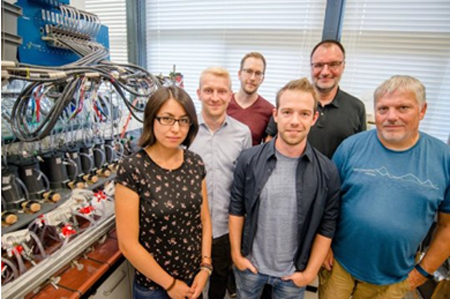HC Plastics News: The new catalyst developed by Ruhr University in Bochum, Germany, enables the sustainable production of plastics and also generates hydrogen as a potential clean energy source. Dulce Morales, Steffen Cychy, Stefan Barwe, Dennis Hiltrop, Martin Muhler and Wolfgang Schuhmann. Source: Ruhr University, Bochum, Germany (RUB) Chemists at Ruhr University (RUB) in Bochum, Germany, have developed a new low-cost catalyst for the production of plastics. It can convert biorefined products into raw materials for synthetic plastics, which will be a sustainable alternative to PET (polyethylene terephthalate), which is currently widely used. At the same time, it can also produce clean energy during the reaction. hydrogen. The study was conducted in collaboration with RUB Labs under the leadership of Dr. Martin Muhler from Dr. Stefan Barwe and Dr. Wolfgang Schuhmann from the Bochum Electrochemical Science Center. The researchers published the study on July 9, 2018 at Angewandte Chemie. “If we no longer use crude oil as a raw material, but use biomass that cannot be used as food, we are taking a big step towards the sustainable chemical industry,†says Wolfgang Schuhmann. Alternative to PET In this study, Bochum researchers developed a nickel boride catalyst because it does not contain any precious metals and is easier to obtain and less expensive than many other catalysts. It can convert the biorefined product HMF (5-hydroxymethylfurfural) to FDCA (2,5-furandicarboxylic acid). “FDCA has a pivotal position in the industry because it can be processed into polyester, which produces a replacement for PET – PEF (2,5-furandicarboxylate), all based on renewables. Raw materials, plants,†explains Stefan Barwe. Hydrogen generation reduces energy consumption In the tests conducted by the Bochum team, the catalyst was able to convert 98.5% of the raw HMF to FDCA in just half an hour, with no other by-products. “We further designed the catalyst to ensure hydrogen efficiency while successfully generating hydrogen,†Stefan Barwe said. This is another innovation in this research. Therefore, researchers can also use this raw material to generate hydrogen as a potential source of energy. Hydrogen is generally obtained from water by electrolysis, which also produces oxygen. When the researchers collected hydrogen while producing FDCA, the energy-consuming reaction step of oxygen release was specifically eliminated. Reaction mechanism The team also used electrochemical methods and infrared spectroscopy to further elucidate the reaction. This is the first time chemists have been able to track in real time which intermediate product converts HMF to FDCA. Editor in charge: Yao Chunlin Alumina Ceramics are ceramic materials based on alumina (Al2O3) for thick film integrated circuits. Alumina ceramics have good conductivity, mechanical strength and high temperature resistance. It should be noted that ultrasonic cleaning is required. Alumina ceramics is a versatile ceramic. Because of its superior performance, it has been widely used in modern society, satisfying the needs of daily use and special performance.The high-purity alumina ceramics have a Al2O3 content of 99.9% or more. Since the sintering temperature is as high as 1650-1990 ° C and the transmission wavelength is 1 to 6 μm, the molten glass is generally used to replace the platinum crucible; Sexual and alkali-resistant metal corrosion is used as a sodium lamp; it can be used as an integrated circuit substrate and high-frequency insulation material in the electronics industry. Alumina Ceramics Alumina Ceramics,Industrial Ceramic,Alumina Ceramics Parts,Wear Resistant Alumina Ceramic SHENZHEN HARD PRECISION CERAMIC CO.,LTD , https://www.hardcm.com
